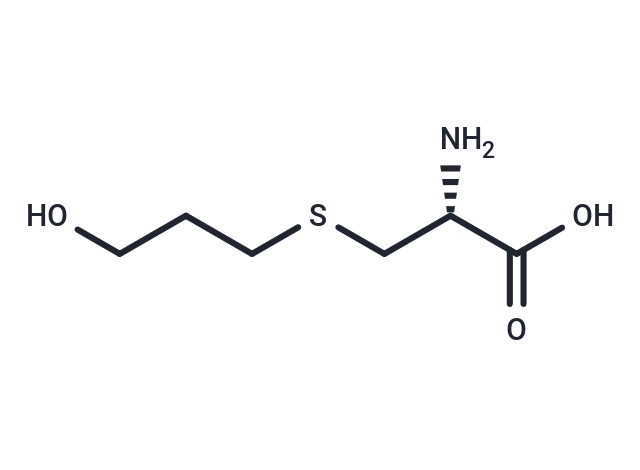Shopping Cart
- Remove All
 Your shopping cart is currently empty
Your shopping cart is currently empty

Fudosteine is a novel mucoactive agent and a MUC5AC mucin hypersecretion inhibitor.

| Pack Size | Price | Availability | Quantity |
|---|---|---|---|
| 50 mg | $30 | In Stock | |
| 100 mg | $40 | In Stock | |
| 200 mg | $56 | In Stock |
| Description | Fudosteine is a novel mucoactive agent and a MUC5AC mucin hypersecretion inhibitor. |
| In vitro | Fudosteine (FDS), a unique mucolytic antioxidant, shows a stronger scavenging effect of Peroxynitrite than N-acetyl-cysteine on DCDHF oxidation in vitro and in sputum macrophages, and also on Peroxynitrite-induced BSA nitration. Fudosteine (0.1 mM) reduces Peroxynitrite-enhanced interleukin (IL)-1beta-induced IL-8 release and restores corticosteroid sensitivity defected by Peroxynitrite more potently than those induced by H(2)O(2) in A549 airway epithelial cells. [1] Fudosteine significantly inhibits increases in GRO/CINC-1 at 10-100 mg/kg, and neutrophils and goblet cells at 30 and 100 mg/kg. Fudosteine inhibits goblet cell hyperplasia by inhibiting GRO/CINC-1 production and/or neutrophil migration. [2] Fudosteine treatment reduces the expression levels of p-p38 MAPK and p-ERK in vivo and of p-ERK in vitro. Fudosteine inhibits MUC5AC mucin hypersecretion by reducing MUC5AC gene expression and the effects of fudosteine are associated with the inhibition of extracellular signal-related kinase and p38 mitogen-activated protein kinase in vivo and extracellular signal-related kinase in vitro. [3] Fudosteine significantly suppresses blood flow of tracheal microvasculature increased by SO(2) exposure. Fudosteine scavenges superoxide anion generated from rat neutrophils, and enzymatically generated from xanthine oxidase-acetaldehyde reaction. [4] |
| In vivo | Fudosteine (500 mg/kg, p.o.) significantly increases the amount of dye excreted into the respiratory tract. Fudosteine increases chloride ion concentration in broncho-alveolar lavage of rats. [5] |
| Molecular Weight | 179.24 |
| Formula | C6H13NO3S |
| Cas No. | 13189-98-5 |
| Smiles | [C@H](CSCCCO)(C(O)=O)N |
| Relative Density. | 1.301 g/cm3 (Predicted) |
| Storage | Powder: -20°C for 3 years | In solvent: -80°C for 1 year | Shipping with blue ice./Shipping at ambient temperature. | ||||||||||||||||||||
| Solubility Information | H2O: 10 mM, Sonication is recommended. DMSO: Insoluble | ||||||||||||||||||||
Solution Preparation Table | |||||||||||||||||||||
H2O
| |||||||||||||||||||||

Copyright © 2015-2025 TargetMol Chemicals Inc. All Rights Reserved.